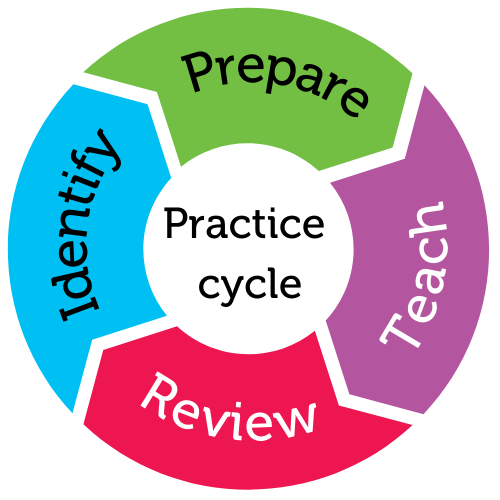
For student year
Helps students to
- hear in the classroom
Helps teachers to
- be heard in the classroom
Summary
For the primary school version of this practice, go to:
Improve your classroom's acoustics (Foundation to year 6)
Schools can be loud places — full of activity and discussion. Students spend an estimated 45%–60% of their school day listening to their teacher and classmates. For some students, however, listening and interacting is made difficult due to the acoustics in the classroom. If a classroom is too loud, students may not be able to hear, focus, or comprehend what’s being said. Conversely, if a student finds hearing the teacher and other students difficult, they won’t be learning or participating to the best of their ability.
Students transitioning from primary school to year 7 may be especially impacted by classroom acoustics, having come from a learning environment that involves only one or two of the same classrooms and the same teachers. Students on the autism spectrum who are particularly sensitive to noise may also find it more difficult to learn in this type of environment.
If students are to succeed at school, they must be able to hear what’s being said. In this practice, you’ll learn how to improve your classroom's acoustics by making your it quieter and your voice louder.
"Improved acoustics could significantly improve attention and reduce response times in students on the spectrum."
Australian Professional Standards for Teachers related to this practice
4.1 - support student participation
1.6 - strategies to support the full participation of students with disability
For further information, see Australian Professional Standards for Teachers AITSL page
Preparing to teach
Improving acoustics
Improving your classroom’s acoustics is easier than you think. You can use two strategies to improve your classroom’s acoustics:
1. Make your classroom quieter by finding and fixing the sources of noise in your classroom.
2. Make your voice louder by using devices that raise your voice so you don’t have to.
Not all recommendations for improving classroom acoustics will work in all classrooms, so you should first consider the nature of your particular classroom. This will help you to decide which recommendations to try first, which to try later, and which you won’t try at all. Before attempting to improve your classroom’s acoustics, you should measure them.
Understanding acoustic terms
Classroom acoustics refers to how sound ‘behaves’ in the classroom. Classroom acoustics affect how well students hear in the classroom. Some terms to be aware of:
• Unoccupied sound level: The sound in the classroom when it’s empty. This sound level is usually reported in A-weighted decibels (dBA). Australian Standards recommend unoccupied sound levels in classrooms should be below 35–45 dBA. 35 dB is about the level of a whisper.
• Occupied sound level: The sound in the classroom when students and teachers are present. This sound level is usually reported in A-weighted decibels (dBA). Australian Standards recommend occupied sound levels in classrooms should be below 50–60 dBA. 50 dB is about the level of someone who is speaking in a normal conversational voice.
• Reverberation time (RT): The time taken for sound to decrease in the classroom. Australian Standards recommend RTs in classrooms should be below 0.3–1.2 seconds from small to large classrooms. Higher RTs make a room echo.
• Speech transmission index (STI): An estimate of how easy it is to hear speech sounds in a classroom. The STI ranges from 0 (no speech sounds would be heard) to 1 (all speech sounds would be heard).
To assess the acoustics of your classroom, you can use an app, such as:
-
National Institute for Occupational Safety and Health’s Sound Level Meter
-
EA LAB’s NoiSee.
In the classroom
Step 1: Try to make your classroom quieter
There are many things you can try to make your classroom quieter:
Identify the sources of noise
|
Inside the classroom |
Outside the classroom |
|---|---|
|
fans |
neighbouring classrooms |
|
air vents |
air conditioning units |
|
chair legs scraping on hard floors |
general-purpose assembly areas |
|
power and cooling systems for things like computers and whiteboards. |
school maintenance work (e.g., lawn mowing) |
|
road traffic |
Reduce noise
|
Simple example |
Complex example |
|---|---|
|
cut tennis balls in half and stick them to the ends of chair legs |
increase the duct length of central air conditioning systems |
Absorb noise by covering hard surfaces with soft
|
Simple example |
Complex example |
|---|---|
|
carpet or rugs on the floor curtains (the heavier the better) over windows, corkboards/soft pin boards over walls netting on the ceiling filled with soft material such as foam strategically place separator boards covered in soft materials such as foam, felt or flannel in the classroom |
install acoustic tiles (special materials designed to absorb sound) on the floors, walls and ceiling. |
Reflect the noise by “bouncing” it out of the classroom
|
Simple example |
|---|
|
strategically place an uncovered separator board in front of a noise source to “bounce” that noise away from the students and out of the classroom |
Isolate the classroom - relevant for “dual cell” classrooms
Typically, concertina dividers separate classrooms visually but not acoustically: You can still hear the class next door.
|
Simple example |
Complex example |
|---|---|
|
use a heavy (the heavier the better) concertina divider that separates the classrooms both visually and acoustically |
build a hard wall between the classrooms |
Audiologists, acoustic engineers and even acoustic architects can specialise in this kind of work. One place you can try to find acoustic engineers in your region is via the Australian Acoustical Society
Step 2: Try to make your voice louder
To make your voice louder, you may wish to try:
- Arrange classroom furniture to reduce the distance between you and your students.
- For some individual children, a Personal Sound Amplification (PSA) system may be recommended (a.k.a. Remote Microphone Hearing Aids or personal FM systems). You wear a microphone and transmitter. The child wears a receiver and earpiece.
- Sound Field Amplification (SFA) systems help raise your voice over the background noise. You wear a microphone and transmitter. A speaker or speakers are placed in the classroom. When functioning optimally, SFA allows you to speak at a comfortable level while the system projects your voice so that it can be easily heard throughout the classroom.
- Create a seating plan and position students you know find hearing difficult closer to the front of the classroom. A seating plan will allow you to support these students without singling them out.
- Speak with students about noise levels at the beginning of the term and then at regular intervals. Remind them noise levels need to be kept to a level that allows all students to learn. Encourage students to approach you if they’re finding it difficult to hear or focus.
Step 3: Trial and error
Adopt a trial-and-error approach to improving your classroom’s acoustics. Sometimes you'll immediately hear the improvement in your classroom after you’ve tried a strategy. Other times, assessing your classroom’s acoustics before and after you’ve applied a strategy might help you to decide if the strategy is working.
Assessing your classroom’s acoustics before and after you’ve applied a strategy might also give you the data you need to support your strategies and possibly get more support to try other strategies
Step 4: Seek professional help
You may also wish to seek professional help to improve your classroom’s acoustics. You could seek help from specialists such as audiologists, acoustic engineers, or acoustic architects.
You can find acoustic engineers in your region on the Australian Acoustical Society website.
Practice toolkit
Practice implementation planner template
We know it's not always easy to keep track of what's working and what isn't. So, we've created this template for you to record and reflect on what you're doing to create more inclusive classrooms. The implementation planner contains:
- guidance around goal setting
- a reflection section (what worked, didn’t work, what to change, and next steps)
- prompting questions.
Implementation planner with examples
Set your professional learning goal for:
Improve your classroom's acoustics (Secondary)
Benefits of goal setting
Setting, working towards, and reflecting on goals helps you grow professionally and improve your practice. You can access AITSL learning resources for teachers to learn more about:How to set goals
The Australian Institute for Teaching and School Leadership recommends using the SMART matrix to frame your goal setting.SMART goals refers to goals that are:
- Specific
- Measurable
- Achievable
- Relevant
- Time-phased
Resources
Australian Accoustical Society website: https://www.acoustics.org.au
Related Practices

Improve your classroom's acoustics
TEACHING PRACTICE
For student years
Helps students to
- hear in the classroom

Meet students' sensory needs
TEACHING PRACTICE
For student years
Helps students to
- engage in tasks
- self-regulate
This practice is from the core research project
Learning Cycle

Set your practice implementation goal
Evidence
This practice was developed as part of the Classroom acoustics project. More information about the evidence informing this practice is available on the project page.

